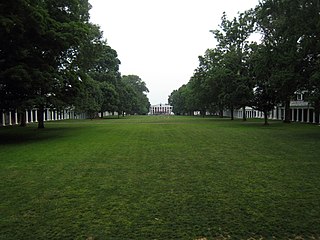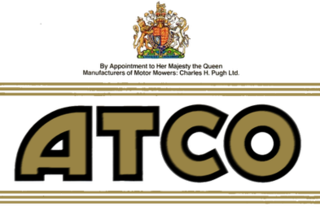Edwin Beard Budding, an engineer born in Eastington, Stroud, was the English inventor of the lawnmower (1830) and adjustable spanner (1842).

A scythe is an agricultural hand tool for mowing grass or harvesting crops. It is historically used to cut down or reap edible grains, before the process of threshing. The scythe has been largely replaced by horse-drawn and then tractor machinery, but is still used in some areas of Europe and Asia. Reapers are bladed machines that automate the cutting of the scythe, and sometimes subsequent steps in preparing the grain or the straw or hay.

A lawn is an area of soil-covered land planted with grasses and other durable plants such as clover which are maintained at a short height with a lawn mower and used for aesthetic and recreational purposes—it is also commonly referred to as part of a garden. Lawns are usually composed only of grass species, subject to weed and pest control, maintained in a green color, and are regularly mowed to ensure an acceptable length. Lawns are used around houses, apartments, commercial buildings and offices. Many city parks also have large lawn areas. In recreational contexts, the specialised names turf, pitch, field or green may be used, depending on the sport and the continent.

A lawn mower is a device utilizing one or more revolving blades to cut a grass surface to an even height. The height of the cut grass may be fixed by the design of the mower but generally is adjustable by the operator, typically by a single master lever or by a mechanism on each of the machine's wheels. The blades may be powered by manual force, with wheels mechanically connected to the cutting blades so that the blades spin when the mower is pushed forward, or the machine may have a battery-powered or plug-in electric motor. The most common self-contained power source for lawn mowers is a small internal combustion engine. Smaller mowers often lack any form of self-propulsion, requiring human power to move over a surface; "walk-behind" mowers are self-propelled, requiring a human only to walk behind and guide them. Larger lawn mowers are usually either self-propelled "walk-behind" types or, more often, are "ride-on" mowers that the operator can sit on and control. A robotic lawn mower is designed to operate either entirely on its own or less commonly by an operator on a remote control.

iRobot Corporation is an American technology company that designs and builds consumer robots. It was founded in 1990 by three members of MIT's Artificial Intelligence Lab, who designed robots for space exploration and military defense. The company's products include a range of autonomous home vacuum cleaners (Roomba), floor moppers, and other autonomous cleaning devices.

Robomow is a manufacturer of robotic lawn mowers. Founded in Even Yehuda, Israel in 1995 by Udi Peless and Shai Abramson, the company provides robotic lawnmowers to the United States and Europe, with prices ranging from hundreds to thousands of dollars/Euros. Robomow mowers are rechargeable. Robomow also comes with its own mobile application for remote and interactive control. The company has been mentioned in several magazines including: Design News, Business Wire, Washington Home and Garden and Vanity Fair. In May 2017, MTD Products Inc announced their intent to purchase Friendly Robotics. In July 2017, MTD Products announced the completion of the purchase of Robomow.

Lawnmower racing is a form of motorsport in which competitors race modified lawnmowers, usually of the ride-on or self-propelled variety. The original mower engines are retained, but blades are removed for safety. The sport attracts all ages, and is usually entered into in a spirit of fun rather than extreme competitiveness, though many participants do take it seriously.

The New Lawn, also known as The Bolt New Lawn for sponsorship reasons, is a football stadium in Nailsworth, Gloucestershire. It has been the home stadium of League Two club Forest Green Rovers since 2006. During the 2007–08 season the stadium was shared with Gloucester City. The stadium has a capacity of 5,147, of which 2,000 is seated. It replaced The Lawn Ground as Forest Green Rovers' home stadium and is expected to be replaced by a new stadium development located near the M5 motorway. In 2020 the ground was renamed The Innocent New Lawn Stadium due to a sponsorship deal with Innocent Drinks. In 2021, the stadium was renamed after the YouTube channel Fully Charged.

Hover Bovver is a 1983 maze video game written by Jeff Minter released for the Commodore 64. A port to Atari 8-bit computers by Aaron Liddiment followed in 1984. Like many of Minter's other games, it has an offbeat sense of humour. The background music is based on the folk tune "Country Gardens" by Percy Grainger, arranged by James Lisney.

Flymo is a hover lawnmower invented by Karl Dahlman in 1964, after seeing Sir Christopher Cockerell's hovercraft. "Flymo" is a brand name of the Swedish company Husqvarna AB, a part of Electrolux from 1978 to 2006. The mower is a variation of the petrol-powered rotary push lawn mower, but uses a fan above the mower's spinning blades to allow the mower's body to hover over the lawn. The mower is claimed to be more manoeuvrable and easier to push than wheeled petrol mowers, while delivering similar results.
The Husqvarna Group is a Swedish manufacturer of outdoor power products including robotic lawn mowers, chainsaws, trimmers, brushcutters, cultivators, and garden tractors. Founded as a firearms manufacturer in 1689, it is one of the oldest continuously running companies in the world. Headquartered in Stockholm, Sweden, the group also produces consumer watering products under the brand Gardena, cutting equipment and diamond tools for the construction and stone industries.

Victa is an Australian manufacturer of outdoor garden equipment, including petrol, electric, and battery-powered lawn mowers, edgers, trimmers, and chainsaws. The brand is best known as a manufacturer of rotary lawn mowers. In the early 1960s the company also built light aircraft, notably the Victa Airtourer, and project homes.

Sensation Lawn Mowers was a commercial lawnmower brand created by Howard Phelps in 1944. The Sensation Lawn Mower Company was located in Ralston, Nebraska, USA.

A zero-turn riding lawn mower is a standard riding lawn mower with a turning radius that is effectively zero when the two drive wheels rotate in opposite direction, like a tank turning in place.

A domestic robot is a type of service robot, an autonomous robot that is primarily used for household chores, but may also be used for education, entertainment or therapy. While most domestic robots are simplistic, some are connected to Wi-Fi home networks or smart environments and are autonomous to a high degree. There were an estimated 16.3 million service robots in 2018.

Atco (Atlas Chain Company) Limited was a British mower company which traded as "Atco Ltd" from 1981 to 1990, making lawn mowers and garden tools. It sold a range of lawn mowers including lawn and garden tractors.
Cecil Elwood Pond was an American businessman, inventor, and entrepreneur. He was the founder of Wheel Horse Products Co. Inc and was the primary inventor of the modern American riding mower.

The Worthington Mower Company, originally called the Shawnee Mower Factory, produced lawn mowers and light-duty tractors in the United States from the early 1920s until around 1959. Founded by Charles Campbell Worthington and run as a family business, in 1945 it was purchased by Jacobsen Manufacturing. It continued to produce tractors and mowers in Stroudsburg, Pennsylvania, until around 1959.
Advanced Lawnmower Simulator is a video game for the ZX Spectrum published as an April Fools' Day joke by Your Sinclair magazine in 1988. The player is tasked with mowing yards with a lawn mower in exchange for rewards. The magazine claimed the game was developed and published by "Gardensoft" and also published a joke review lauding it and released the game on a cover tape. It was not officially labeled as a prank until August 1990. The concept has inspired other games with similar titles.
EEVE is a Belgian company that develops and produces personal robots.























